
Film Review: Turning Red
Film Reviews
Turning Red
Director: Domee Shi
Pixar
Streaming on Disney+ 03.11
There is nothing I love more than a Pixar film, but it’s no secret that the studio has battled a reputation for being a predominantly white boy’s club. Turning Red, the 25th film under the Pixar banner, does a lot to change that image, both behind the scenes and on screen.
Turning Red centers around Meilin Lee, who is voiced by newcomer Rosalie Chiang. Mei is a 13-year-old Chinese-Canadian girl who is on the cusp of womanhood, and she feels held back by her protective and controlling mother, Ming (voiced by Sandra Oh, Grey’s Anatomy, Killing Eve). Mei wants to be a liberated adolescent and to live life to its fullest, but she also thrives on her mother’s approval and is terrified of losing it. There are a lot of emotions mixing inside Mei, and she awakens one morning to discover that she has transformed into a giant red panda. When she returns to normal, Mei learns that the panda curse is something that all of the women in her family experience. Mei remains herself as long as she stays calm. If she becomes too excited, stressed, embarrassed or angry, she unleashes her inner panda.
Director Domee Shi, who co-wrote Turning Red along with acclaimed playwright Julia Cho, gave us brilliant and profound Oscar-winning Pixar short Bao, and her feature debut lives up to the expectations set by that pedigree. Turning Red is arguably Pixar’s most groundbreaking and daring film since Inside Out, and it’s a beautifully sensitive, riotously funny tale of the pitfalls of adolescence. In many ways, a case could be made that the story is merely a variation on the 1985 comedy Teen Wolf, but Shi takes the premise and adds layer upon layer of subtext and insight. While Disney animation is often considered to be aimed at girls, there’s never been a mainstream animated movie that deals with the issues that Turning Red addresses with such elegance, understanding and good humor. The cast of characters is rich and endearing, with Mei’s core group of friends, Abby, Miriam and Priya, providing support for her, adding another layer of heart.
Chiang is natural and lovable Mei, bringing a lot of reality and magnetism to the role, and Oh makes Ming an imposing, infuriating and quite sympathetic presence. If there was a particular standout in the cast for me, it would have to be the great James Hong, the 93 year-old character actor known for Blade Runner, Kung Fu Panda and for yelling “Cartwright!” on Seinfeld. Hong, as the wise but playful Mr. Gao, the expert in the panda curse, is the kind of minor character that you become instantly attached to, and he provides plenty of laughs without overmilking it.
Turning Red features a gorgeous and bouncy musical score by Ludwig Goransson (Black Panther, The Mandalorian) as well as catchy new songs by Billie Eilish and Finneas O’Connell, the latter of whom provides a voice in the film as a member of Mei’s favorite boy band. The choice to set the movie in between 2002 and 2003 not only makes it the first big early 2000s nostalgia film that doesn’t involve terrorism, it also gives millenial mothers an extra window into connecting with their daughters with an on-screen demonstration of their similarities. But in all of the discussion of how the film resonates with girls, it must be pointed out that Turning Red does a solid job of not making boys feel like the movie holds nothing for them, and it carries on the finest Pixar tradition in providing something for everybody.
Turning Red is arguably the best major release of 2022 up to this point, and while it’s a shame that it can’t be seen on the big screen, I’m also glad to have the opportunity to watch it (far too many times) at home when I need a break from the darker, heavier fair that I see so much of as a critic. It is an escape from the worrisome state of the world right now, a perfect ray of sunshine that couldn’t have come at a better time. –Patrick Gibbs